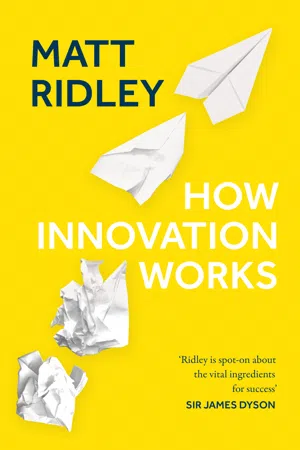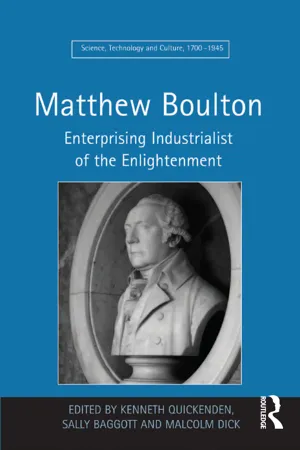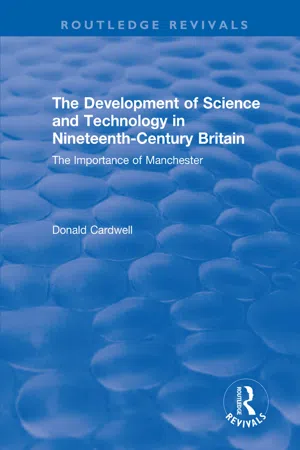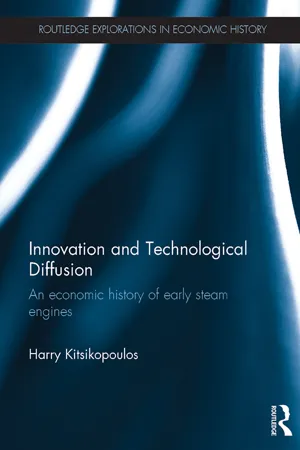Technology & Engineering
James Watt
James Watt was a Scottish inventor and mechanical engineer known for his improvements to the steam engine, which played a crucial role in the Industrial Revolution. His development of the separate condenser significantly increased the efficiency and power of steam engines, leading to widespread adoption in various industries. Watt's innovations revolutionized the field of engineering and had a profound impact on the advancement of technology.
Written by Perlego with AI-assistance
Related key terms
Related key terms
1 of 4
Related key terms
1 of 3
11 Key excerpts on "James Watt"
- eBook - ePub
- Arne Hessenbruch, Arne Hessenbruch(Authors)
- 2013(Publication Date)
- Routledge(Publisher)
W Watt, Jamcs 1736–1819 British engineer and inventorArago, M., Historical Eloge of James Watt, translated from the French by James Patrick Muirhead, London: John Murray, 1839Dickinson, H.W., James Watt, Craftsman and Engineer, Cambridge: Cambridge University Press, 1936; New York: Kelley, 1967Dickinson, H W. and Rhys Jenkins, James Watt and the Steam Engine, Oxford: Clarendon Press, 1927Dickinson, H.W. and H.P. Vowles, James Watt and the Industrial Revolution, London and New York: Longmans Green, 1943Muirhead, James Patrick, The Origin and Progress of the Mechanical Inventions of James Watt Illustrated by His Correspondence with His Friends and the Specifications of His Patents, 3 vols, London: John Murray, 1854Musson, A.E. and Eric Robinson, Science and Technology in the Industrial Revolution, Manchester: Manchester University Press, and Toronto: Toronto University Press, 1969Robinson, Eric and A.E. Musson, James Watt and the Steam Revolution: A Documentary History, London: Adams and Dart, and New York: Kelley, 1969Robinson, Eric and Douglas McKie (eds), Partners in Science: Letters of James Watt and Joseph Black, London: Constable, and Cambridge, Massachusetts: Harvard University Press, 1970Smiles, Samuel, Lives of the Engineers: The Steam-Engine: Boulton and Watt, revised edition, London: John Murray, 1878Williamson, George, Memorials of the Lineage, Early Life, Education and Development of the Genius of James Watt, London: Constable, 1856James Watt’s crucial improvements to the steam engine have rightly dominated biographical works about him, but this has generally been to the exclusion of most of his other inventions and discoveries. The invention for which he is best remembered is the addition of the separate condenser to the Newcomen engine. Not only did this make a much more powerful and economical engine, but it led to his development of the steam engine from a machine that could only pump water into one that could turn rotating machinery directly. Watt solved the problems he faced by the application of scientific principles, and so he may be said to be the originator of scientific engineering. - eBook - ePub
Sci & Culture in the Nineteenth Century
Understanding the Origins of the Steam Age
- David Philip Miller(Author)
- 2009(Publication Date)
- University of Pittsburgh Press(Publisher)
Thus those accounts of the Indicator Diagram that assimilate Watt's use of it to its later conceptualization as a measure of work or energy in mid-nineteenth-century thermodynamics are misleading. They read Watt's understanding of the steam engine and the indicator diagram through the historical fog of both the chemical and the thermodynamic revolutions.Passage contains an image
7 Conclusions
James Watt was certainly a 'man o' pairts', but he was also a coherent whole. For too long our historical understanding of him has emphasized the many parts, seeing the whole only dimly, if at all. By pursuing the links between his practical and theoretical work I have tried to set this to rights. Watt was an engineer. He was certainly an expert, as J. D. Forbes put it in his discussions of these questions, at contrivance. Forbes admired Watt's invention of the parallel motion as showing Watt's genius for contrivance, but he argued that this in itself would never have been the basis for 'reputation'. Watt's reputation derived from his quality as a philosophic engineer. I have argued that what gave his engineering its philosophic quality or dimension was largely chemical in character. Watt was a chemist, whose chemistry of heat provided the philosophical dimension to his engineering. That philosophical dimension was very different from the equivalent dimension of what became known in the mid-nineteenth century as 'engineering science'. In engineering science heat was understood as a form of energy, convertible into other forms according to the fundamental laws of thermodynamics. All this was foreign to the intellectual world that Watt inhabited. However, because Watt was adopted as an icon and founding father of their field, the engineering scientists of the nineteenth century were not averse to smoothing over some of the differences between his world and theirs. Watt the chemist and engineer became Watt the mechanical engineer.In my early chapters I showed how popular representation of Watt, which became a minor industry itself in the nineteenth century, presented the mechanical Watt. This was a natural and easy thing to do given the association of Watt in the popular mind with contrivance. The products of that genius for contrivance, or so it seemed, were everywhere in Victorian Britain, the engines, the linkage and control mechanisms to convert the power of those engines into useful work, the indicators designed to monitor, measure and adjust their performance. Whether as the geometer of Chantrey's statues, reordering mechanical space to institute the separate condenser, or as the bearer of devices, conceived as the product of a craftsman's skill, in later nineteenth-century statues, the mechanical Watt was carved in stone and cast in brass to sit in Westminster, Glasgow, Edinburgh, Birmingham, Manchester, Leeds and Greenock. The indicator that the Watt statue installed in Greenock in the early twentieth century grasped triumphantly in its hand was recognized by those who could recognize it at all either as the stethoscope of the practical working engineer or as the device which produced the 'indicator diagram' that bridged the technological marvels of steam power and the scientific mysteries of thermodynamics. Here, too, Watt the great mechanician was celebrated. - eBook - ePub
- Stella Davies(Author)
- 2013(Publication Date)
- Routledge(Publisher)
5 The Giant, SteamIN 1769, the same year in which Arkwright patented the water-frame, James Watt patented the steam-engine. It was first used for pumping the water from mines but soon it was adapted to drive machines of many kinds. Steam-engines were installed in water-power mills to run the machines during a shortage of water; new textile-mills using steam instead of water began to be built; steam-engines were used in iron-making; in the early nineteenth century steamships sailed on the River Clyde, many industries, such as brewing, pot- and china-making used steam power in one or other of the processes.An enthusiastic account of the wonders of the steam-engine, written in the early nineteenth century, claimed that the power of four million men had been added, by its aid, to the resources of Britain. Only a guess, it is nevertheless expressive of how people regarded steam. A giant had arrived and the industrial revolution gathered immense speed and force with the added weight. The invention and perseverance of James Watt made this possible. His life will be told in some detail because it enables us to see another aspect of the industrial revolution and brings us into contact with people from many walks of life.Many of the men who, in association with Watt, launched the steam-engine were wealthy and well educated, for to produce it on a large scale needed a great deal of money and business knowledge. To make the engine and keep it in order required more skill than was necessary for the older types of machines. The new technical knowledge gained in developing the steam-engine was the beginning of modern engineering. This can be seen happening at the workshop level and it is possible to gain some knowledge of the life of the metal-worker and mechanic. Moreover, in considering the life of James Watt we cover a large part of Great Britain, beginning in Scotland, following him to Birmingham and making journeys with him to London, Cornwall, Wales and other districts. Something, also can be learnt of the people who bought his engines and the men who worked them. - Abraham Wolf(Author)
- 2019(Publication Date)
- Routledge(Publisher)
By the middle of the eighteenth century probably several hundred Newcomen engines were rendering useful, if expensive, service at pits in the North, the Midlands, in Cornwall, and abroad. So wasteful were they in fuel consumption, however, that even after improvements introduced by Brindley and Smeaton, their use was confined to the raising of water from coal mines, where low-grade, almost unmarketable, coal was plentiful, and from metalliferous mines, where the yield was so rich as to justify almost any expense to keep the workings clear of water. Could efficiency of operation be markedly improved, a vast field lay open for the extended use of power— an opportunity which many investors strove to make use of. Foremost among these improvers of the Steam-Engine was James Watt.Watt was not trained as an engineer; the trade he learned as a young man was that of instrument-maker. His attention was first drawn to the problem of steam-power in 1763, when he was called on to repair a model of a Newcomen engine which belonged to the College of Glasgow. He succeeded in making the model work; but he was astonished at the disproportion between the large amount of steam generated and the small size of the working cylinder. Having discussed the properties of steam with John Robison (1739–1805), at that time a student at the college, and with Dr. Joseph Black, who was engaged in the investigations which led to his discovery of latent heat, he sought to diagnose, and if possible eliminate, the defects which led to such serious losses. He quickly realized that the large quantity of water injected to condense the steam, and so produce a vacuum, also chilled the cylinder, and that the next charge of live steam had first to reheat the cylinder, thereby losing heavily in volume and pressure, by condensation. It was two years, however, before his occupation with this problem suggested to him that the solution lay in condensing the steam in a separate vessel, always cold, and kept vacuous by the use of an air-pump, while the working cylinder was kept hot by means of a steam-jacket. An experimental model worked well enough to convince him that the method deserved a trial on a larger scale. (See Illustr. 306 .)Illustr. 306.—Section of Watt’s Experimental Model of the Separate Condenser Engine (Restored)The step from a small model to a large engine immediately introduced three serious difficulties. Precision tools were not yet invented; the assistance of skilled mechanics was not available; and the cost of materials, tools, and such labour as was available, were beyond his means. In 1765, moreover, Watt married; and, driven by the necessity of earning a living, undertook survey work and the laying out of canals. Never physically robust, this strenuous outdoor work left him little time or energy for steam-engine experiments. He might, indeed, have abandoned the idea as beyond his powers of development had he not in that same year been introduced by Dr. Black to the notice of Dr. John Roebuck, of the Carron Ironworks.- eBook - ePub
- Caithness, James Sinclair, 14th earl of(Authors)
- 2005(Publication Date)
- Perlego(Publisher)
I must not detain you much longer before I proceed to the great Watt, but I will just name Newcomen, who invented an engine with a cylinder, and introduced a beam, to the other end of which he fixed a pump rod like a common or garden pump. He made the weight of the pump and beam to lift the piston, and then let the steam enter below the piston and condensed it by a jet of water, thus causing a vacuum, when the pressure of the atmosphere drove the piston from the top to the bottom of the cylinder and lifted the pump rods in the usual way. There were various cocks to be opened and shut in the working of this engine for the right admission of steam and water at the required moments, a task which was performed by boys who were termed cock-boys. I will now mention an instance which, though in practice not to be imitated, yet was one of those happy accidents which sometimes turn out for the best. One of these boys, like many, more fond of play than work, got tired of turning these cocks day by day, and conceived the idea of making the engine do it for itself. This idle boy—we will not call him good-for-nothing, as he proved good for a great deal in one way—was named Humphrey Potter, and one day he fixed strings to the beam, which opened and shut the valves, and so allowed him to play, little thinking this was one of the greatest boons he could possibly have bestowed on the world at large, for by so doing he rendered the steam-engine a self-acting machine.We now come to a period which was destined to advance the cause of steam to a far greater extent—in fact, the time which rendered the steam-engine the useful and valuable machine it now is. This is the time of James Watt. This great man, be it said to the credit of Scotland, was born in Greenock, on the Clyde, on the 19th January 1736. His grandfather was a farmer in Aberdeenshire, and was killed in one of the battles of Montrose. His father was a teacher of mathematics, and was latterly chief magistrate of Greenock. James Watt, the celebrated man of whom I now speak, was a very delicate boy, so much so, that he had to leave school on account of his health, and was allowed to amuse himself as he liked. This he did in a scientific way, however, as an aunt of his said to him one day: "Do you know what you have been doing? You have taken off and put on the lid of the teapot repeatedly; you have been holding spoons and saucers over the steam, and trying to catch the drops of water formed on them by it. Is it not a shame so to waste your time?" Mrs. Muirhead, his aunt, was little aware that this was the first experiment in the way which afterwards immortalised her nephew. - eBook - ePub
How Innovation Works
And Why It Flourishes in Freedom
- Matt Ridley(Author)
- 2020(Publication Date)
- Harper(Publisher)
Just how much Watt’s litigiousness delayed the expansion of steam as a source of power in factories is a hotly contested issue, but the ending of the main patent in 1800 certainly coincided with a rapid expansion of experiments and applications of steam. Indeed, one source of steady and incremental improvement in the efficiency and penetration of steam engines came as a result of the publication of a journal, Lean’s Engine Reporter, founded by a Cornish mining engineer named John Lean, which acted like an open-software movement, disseminating suggestions for improvement among many different engineers. My point is simple: Watt, brilliant inventor though he undoubtedly was, gets too much credit, and the collaborative efforts of many different people too little. Five years after Watt died in 1819, there was a subscription to build a monument to him, unusual in those days when monuments were mostly to those who won wars. The editors of a journal called The Chemist had this to say, rather perceptively: ‘He is distinguished from other public benefactors, by never having made, or pretended to make it his object to benefit the public . .. This unpretending man in reality conferred more benefit on the world than all those who for centuries have made it their especial business to look after the public welfare.’ Thomas Edison and the invention business Some time later came an energy innovation that stands symbolically for the whole field of invention: the light bulb. As a patriotic north-easterner, I cannot resist pointing out that one of the light bulb’s innovators lived within a few miles of the River Tyne in Gateshead. His name was Joseph Wilson Swan - eBook - ePub
How the World Became Rich
The Historical Origins of Economic Growth
- Mark Koyama, Jared Rubin(Authors)
- 2022(Publication Date)
- Polity(Publisher)
a) characterizes Watt’s efforts as epitomizing the private R&D model of technological change. Major improvements in pumping had to await the expiration of Watt’s patent, but after 1800 there were dramatic improvements in steam technology. Although it took decades for steam engines to be widely adopted, they ended up revolutionizing many industries, including transport. Steam locomotives and steamships would become the predominant form of transport in the 19th century.According to Allen (2009a), inventions like the steam engine, and improvements upon those inventions, were driven by high British wages. Entrepreneurs sought labor-saving methods to avoid paying those high wages. But why were they so high? Part of the answer has to do with the developments we outlined in the previous section. Allen accounts for high British wages in the context of the comparative commercial success achieved during the 17th and 18th centuries, in which overseas trade played a particularly important role.The Watt steam engineFigure 8.7Source: Figure in the public domain, available at https://en.wikipedia.org/wiki/Watt_steam_engine#/media/File:Watt_steam_pumping_engine.JPG .Cheap energy is another part of Allen’s story. Cheap energy was partly the result of prior developments. The coal industry developed in England in response to a shortage of timber in the 16th century. In particular, the growth of London exhausted nearby sources of timber and induced a switch to coal-burning. This was a drawn-out process that required innovations like improvements to the chimney. It also provided incentives for the expansion of the mining industry. Cheap coal was a particularly important spur to the development of steam engines (see Figure 2.10 ).Allen’s argument has come under critical scrutiny. First, technological change does not always economize on the most expensive factor. For profit-maximizing entrepreneurs, all costs are economized. The conditions under which directed technological change seeks to economize on the most expensive factor depend on the degree of substitutability between labor and capital. We do not yet have a good estimate of whether these conditions were met in Industrial Revolution Britain. - eBook - ePub
- Matt Ridley(Author)
- 2020(Publication Date)
- Fourth Estate(Publisher)
Just how much Watt’s litigiousness delayed the expansion of steam as a source of power in factories is a hotly contested issue, but the ending of the main patent in 1800 certainly coincided with a rapid expansion of experiments and applications of steam. Indeed, one source of steady and incremental improvement in the efficiency and penetration of steam engines came as a result of the publication of a journal, Lean’s Engine Reporter, founded by a Cornish mining engineer named John Lean, which acted like an open-software movement, disseminating suggestions for improvement among many different engineers. My point is simple: Watt, brilliant inventor though he undoubtedly was, gets too much credit, and the collaborative efforts of many different people too little. Five years after Watt died in 1819, there was a subscription to build a monument to him, unusual in those days when monuments were mostly to those who won wars. The editors of a journal called The Chemist had this to say, rather perceptively: ‘He is distinguished from other public benefactors, by never having made, or pretended to make it his object to benefit the public … This unpretending man in reality conferred more benefit on the world than all those who for centuries have made it their especial business to look after the public welfare.’ Thomas Edison and the invention business Some time later came an energy innovation that stands symbolically for the whole field of invention: the light bulb. As a patriotic north-easterner, I cannot resist pointing out that one of the light bulb’s innovators lived within a few miles of the River Tyne in Gateshead. His name was Joseph Wilson Swan - eBook - ePub
Matthew Boulton
Enterprising Industrialist of the Enlightenment
- Sally Baggott, Kenneth Quickenden, Kenneth Quickenden(Authors)
- 2016(Publication Date)
- Routledge(Publisher)
This had led people to disbelieve calculations that Boulton supplied to Watt and to dismiss him as incompetent when, in fact, the calculations were correct and just what Watt needed. The important point to take from this for our current concern is that Boulton could not only handle the technical aspects of steam engines but also demonstrated technological knowledge that enabled him to see whether, and how, marketable technologies could be constructed. A critic might argue – in concert with Rupert Hall’s ghost – that these technicalities are not abstract science. Boulton’s work with steam engines was between the technical and the entrepreneurial. Let’s accept the scientific/technical distinction for the moment, much against my inclinations, and pursue Boulton into spaces between abstract science and the entrepreneurial. Boulton could and did take his entrepreneurial gaze deeper into the science of engines. An early example of this concerned the theory and practice of boiler design. Even before Watt came on the scene, Boulton, Benjamin Franklin and Erasmus Darwin were discussing steam engines. As the story goes, Boulton’s worries about the possible lack of water power to sustain his manufactory led him to serious investigation of steam engines from the mid 1760s. He pursued his own steam project until he met Watt in 1768. Boulton had built a model steam engine which, early in 1765, he had transported to London for Franklin, and others, to examine. 27 Writing to Boulton in December 1765, Darwin expressed curiosity about how Boulton’s steam engine had been received by Dr Franklin and what Franklin’s observations on it had been. Darwin, Boulton and Dr William Small had evidently been discussing boilers and their optimal design. This question involved them in considering philosophically the phenomenon of evaporation in general - eBook - ePub
The Development of Science and Technology in Nineteenth-Century Britain
The Importance of Manchester
- Donald Cardwell, Richard Hills(Authors)
- 2017(Publication Date)
- Routledge(Publisher)
Réflexions was being published. Poncelet, a very able theorist, was quite aware that practical needs must always outweigh the abstract ideal. And, in 1822, G. J. Christian, a writer on industrial mechanics, had strongly criticized the engineer who exalted theory at the expense of practice.This, then, was not a simple matter of practical men versus theorists, of craftsmen against scientists. It had deeper implications. The exemplary engineer, certainly in the field of steam power, was James Watt, the man who combined practice and science and who had thereby given a great impetus to systematic technology. Watt had shown how, by isolating and paying meticulous attention to important factors, it was possible radically to improve the steam engine. No one could have been more scientific than Watt, nor could his success have been greater. Yet it had been achieved without the construction of general theories. Apparently following in this tradition, scientific investigations of the time were concerned either with such problems as the determination of the variation of steam pressure with temperature47 or with empirical inquiries like the extended field studies of Joel Lean into the relative long-term economies of high- and low-pressure steam engines.48It might appear, at first sight, that Carnot's demonstration that the maximum power obtainable from a given fall of caloric is independent of the nature of the working substance would be of interest to engineers and scientists. However, by this time, some knowledge had been gained of the suitabilities of different working substances. Air had been proposed as a working substance by the Niepce brothers,49 Sir George Gayley,50 P. F. Montgolfier,51 and others. According to I. K. Brunel, his father had carried out experiments on Montgolfier's behalf to show that "the amount of mechanical power, derived from the effect of a given amount of caloric on gaseous bodies was not greater than that produced by the expansion of water into steam, and that practically it was not so generally applicable. The researches of Sir Humphry Davy and Mr Davies Gilbert confirmed this result." 52 - eBook - ePub
Innovation and Technological Diffusion
An economic history of early steam engines
- Harry Kitsikopoulos(Author)
- 2015(Publication Date)
- Routledge(Publisher)
p. 23.BibliographyAlderson, M. A., An essay on the nature and application of steam (London: Sherwood, Gilbert, and Piper , 1834).Arago, M., “History of the steam engine, with a reply to the criticisms to which the first publication of the article gave rise”,Annual of the Board of Longitude,1836.Arago, M.,Life of James Watt,3rd ed. (Edinburgh: A. & C. Black , 1839).Armytage, W. H. G.,A social history of engineering,4th ed. (London: Faber and Faber, 1976).Basalla, G.,The evolution of technology( Cambridge, England and New York: Cambridge University Press , 1988).Bate, J.,The mysteryes of nature and art(London: 1st edition printed by T. Harper for R. Mab, 1634; facsimile edition Norwood, NJ: Walter J. Johnson, 1977).Bourne, J., A treatise on the steam engine in its application to mines, mills, steam navigation, and railways (London: Longman, Brown, Green & Longmans , 1846).Briggs, A., The power of steam: an illustrated history of the world’s steam age (Chicago: University of Chicago Press , 1982).Clark, D. K., An elementary treatise on steam and the steam-engine, stationary and portable (London: Lockwood & Co., 1875).Cohen, H. F., “Inside Newcomen’s fire engine, or: the scientific revolution and the rise of the modern world”,History of Technology,25 (2004), pp. 111–32.Daumas, M., ed., A history of technology and invention, progress through the ages. Vol. 2, The first stages of mechanization (New York: Crown Publishers Inc., 1969).Dickinson, H. W., with a new introduction by A. E. Musson.A short history of the steam engine (New York: Augustus M. Kelley, 1965).Farey, J., A treatise on the steam engine, historical, practical and descriptive (London: Longman, Rees, Orme, Brown and Green, 1827).Ferguson, E. S., “The origins of the steam engine”,Scientific American,210, 1 (Jan. 1964), pp. 98–107.Fletcher, J. M., and A. J. Crowe, An early steam engine in Wednesbury: some papers relating to the coal mines of the Fidoe family, 1727–9
Index pages curate the most relevant extracts from our library of academic textbooks. They’ve been created using an in-house natural language model (NLM), each adding context and meaning to key research topics.
Explore more topic indexes
Explore more topic indexes
1 of 6
Explore more topic indexes
1 of 4










